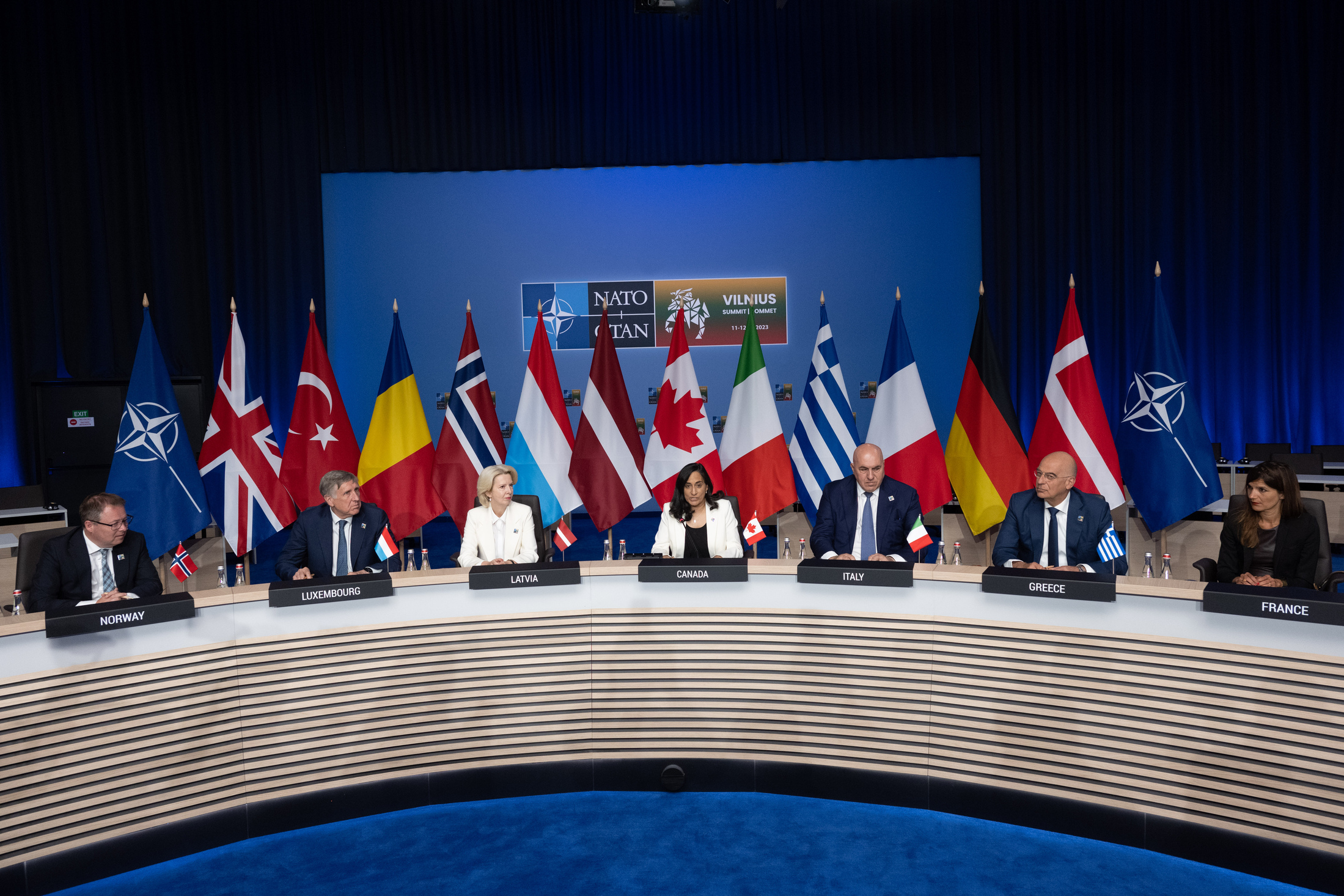How NATO Is Adapting to Climate Change
A new research project, led by UC Irvine associate professor of political science, Heidi Hardt, is exploring why—and how—member states are adapting NATO to climate change in certain areas but not in others. She and her co-author Jackie Burns argue that climate change is damaging NATO’s ability to collectively defend its 31 member states. In this interview, Dr. Hardt talks with IGCC associate director Lindsay Shingler to discuss their research evaluating NATO’s progress following the organization’s pledge to become a leader in understanding and adapting to the impact of climate change on security.
You lead an IGCC grant that explores why and how NATO member states are adapting to climate change. What does NATO do and why is it important?
First and foremost, NATO is a political-military organization established in 1949 to provide collective security for Americans, (at the time Western) Europeans, and Canadians following World War II. Its 31 member states are called Allies. NATO is unlike other international organizations in that it’s both an international organization—meaning essentially a club of countries with a common mission—as well as an alliance, meaning that states have committed to come to one another’s defense if one of those allies is attacked. That component, which is referred to as collective defense, is codified in Article V of the NATO Treaty.
NATO has three main tasks: collective defense; crisis management and prevention, which refers to everything from military operations to diplomacy; and cooperative security, which encompasses things like sharing best practices, training together, and cooperation on counterterrorism, cybersecurity, demining, and more.
NATO has gained attention because of the Ukraine war, and particularly some of the rhetoric that President Putin has used, trying to link NATO’s history of enlargement to his justification for the illegal invasion of Ukraine. But it’s the central pillar within Europe’s security architecture and provides security to the entire Atlantic region—Europe, the United States, and Canada. Article V sends a signal to actors outside the Alliance that there are very high costs and significant risks to attacking any single ally within NATO. NATO is also important because it institutionalizes the rules-based order in ways ranging from ensuring that states respect one another’s sovereignty, enshrining the norm of non-intervention, respecting the UN Charter, and respecting the importance of democracy.
The third reason NATO is important has to do with NATO’s nuclear umbrella. Because several allies are nuclear states, the Alliance both deters attacks from outside and disincentives other NATO allies from proliferating. That’s really important for the state of security in the world. The fewer nuclear weapons that exist, the better for society, and the less risk of an error or something going wrong.
The focus of this grant is how climate change is impacting NATO. What do we know about NATO’s environmental footprint, and how does climate change impact the scope of NATO’s mission?
NATO is ultimately a collective defense organization, and the defense industry is unfortunately a very, very dirty industry in terms of carbon emissions. One consequence of the Ukraine war has been a buildup in the number of troops in countries along NATO’s borders with Russia and that has significant consequences for NATO’s environmental footprint. Forward deployment on the eastern flank means there are more tanks out there, they’re having to expand supply chains to access more fuel, they’re having to feed more troops, they’re having to move and fuel more planes.

Ukrainian T-64BM tank crews training in 2017. Photo courtesy of the 7th Army Training Command.
At the same time, the Ukraine war has illuminated to a lot of allies the importance of energy security and the importance of not being so dependent on fossil fuels, especially because many allies have long been dependent—and some of them still are—on Russian energy. So, there’s been a lot of discussion within NATO about vulnerabilities that exist, and how we can plug those vulnerabilities. Ukraine may be shifting the discussions on energy security and resilience.
NATO Allies agreed in the 2022 Strategic Concept that they want NATO to become the leading international organization when it comes to understanding and adapting to the impact of climate change on security. So, what is NATO doing?
So, there are things that are more public-facing, and there are things happening internally. After the summit in Vilnius, three new climate reports came out. One was a progress report looking at what NATO itself is trying to do to be more climate friendly. When I say NATO, I mean NATO’s infrastructure, NATO bases, NATO headquarters. Another report is a best practices compendium and there has also been the release of a methodology report, which tries to provide some transparency on how NATO is measuring its own impact. The environmental footprint of the NATO enterprise is actually not well understood or easy to determine. That’s because many of these bases and the infrastructure itself, are the result of contracts with individual Allies. So, for example, the Allied Command Transformation sits in Norfolk, Virginia on a U.S. naval base. When you think about threats to that base due to rising sea levels for example, that’s also a threat for NATO because of the extensive NATO structure that is housed there. Sorting out how to address those risks requires complex conversations among all the allies.
One major public-facing thing that NATO has done, which is important, is putting together a NATO Climate Change and Security Center of Excellence—a space for sharing knowledge and best practices on adaptation on climate security. That’s important because some allies within NATO have already made very advanced commitments within their own militaries to cut carbon emissions and convert to green technologies. Other allies are not anywhere near that. The Center of Excellence, which will be based in Montreal, Canada, will allow allies to come together and learn from one another.
NATO has also been hiring full-time climate experts and identifying individuals within delegations to determine who will be the climate point person and who bureaucrats can visit to get a sense of what the ally’s position is. That’s important in an organization like NATO where there is a lot of turnover.
You indicated in a recent IGCC blogpost that NATO has traditionally been behind the curve on climate efforts—why?
In the journal PLOS ONE, there was a study done on climate adaptation in different international organizations, and it looked comparatively at the extent to which the organization changed frameworks, policies, budgets, and other areas to adapt between 1990 and 2017. And it found that NATO was fourth from the bottom. NATO is late to the game; it didn’t have an action plan until 2021. Yes, technically, back in 2010, it had identified climate as a concern. But it didn’t really get “teeth” until 2021.
NATO also has certain disadvantages in terms of its decision making relative to organizations like the European Union. It does everything by consensus, which means that at any point, any single ally can block progress. That’s part of the reason why it’s been so slow relative to other organizations. Internally, the decision-making process is a little more challenging.
One thing that I also thought was really interesting, by contrast with my co-authored research on the Women, Peace, and Security agenda, NATO does have someone at a very high level directly advising the Secretary-General on gender and security issues, but does not have an equivalent climate security adviser. That is, there is not a specific point person at negotiations considering what’s the climate impact of this? What are the vulnerabilities that we need to be aware of?
How will a heating world impact NATO’s infrastructure and mission?
So many different areas will be affected. There are forced first order and second order effects. Second order effects are the broader issues, such as climate migration—the increased demands on the militaries and the Allies themselves as we have more climate migrants who move into what would be considered NATO territory.
First order effects have to do with the impact of things like rising sea levels, extreme heat, and wildfires. These threaten bases, they threaten exercises and training, and the health of individual soldiers. One example we heard was about an ally that basically had to go back to one of the NATO commands and say: look, we can’t fulfill our training obligations because we’re dealing with a massive wildfire problem. We’ve also heard many stories about problems ensuring equipment can withstand extreme heat. All of these things affect broader issues of operational preparedness.
In terms of NATO’s mission, climate change drives increased demand for humanitarian response. This is a really big problem, because individual allies are now having to deal with bigger issues at home, whether it’s flooding, whether it’s wildfires, etc. How do militaries respond to these increased demands and fulfill their defense commitments to the alliance—particularly as we’re simultaneously seeing all of these larger commitments that were made at the summit for enhanced deterrence and defense.
What do you think is most concerning about NATO’s climate agenda?
Leadership is so critical. Right now, we have a Secretary-General who’s very active on climate change. The question is: how sustainable are these efforts? There’s also the question of whether the issue will get siloed away in the Center of Excellence without enough people across the Alliance taking the issue seriously.

Signing Ceremony of the Climate Change Centre of Excellence. Photo courtesy of NATO.
You’ve been conducting interviews in Brussels, Washington, D.C. and in at least eight countries across the Alliance thus far. What have you been learning and hearing? Are there internal critics of NATO’s climate approach, constituencies that are for or against? How do people inside view climate change in terms of the sort of level of priority? And what do they view as barriers?
In terms of the motivators, I already mentioned the Secretary-General, who had already been very active on climate issues in his home country. That helped because this was already an issue in which he had very deep expertise. We’ve also seen public opinion really moving towards saying that climate security is a really major issue. And then you have individual foreign ministries and the militaries of several big countries like the U.S. and Canada saying, hey, this is a priority for us. And then getting the bureaucratic leadership on board—all those pieces coming together was really critical for seeing movement on climate. And then there’s the strategic document itself. The Strategic Concept is preeminent. After the NATO Treaty, it is the most important document and is meant to set the vision for NATO for the next decade. And so it was very helpful back in 2010 that climate change was noted as a concern. It started this ripple effect of people saying that maybe NATO should be thinking about climate.
There are a lot of barriers to change. Probably the biggest is the fact that, because NATO is a collective defense organization, climate is not something that’s listed as part of its mandate. Particularly at a time when the Ukraine war is happening, there are concerns that there is a tradeoff: either we’re adapting to and prioritizing climate change or we’re focusing on our collective defense, especially against further Russian aggression. That is a concern that we heard repeatedly.
Other barriers have to do with things that are more obvious such as climate deniers, etc. But from the perspective of those who would like to see further adaptation, some of the biggest political roadblocks have already been passed. The fact that there was an entire paragraph devoted to climate change and that it’s mentioned ten times in the Strategic Concept—NATO’s second most important document after the NATO Treaty itself—shows that climate security is a priority, and that sends a message to allies and the broader world that considering and adapting to climate threats has become part of what NATO does.
Thumbnail credit: NATO
